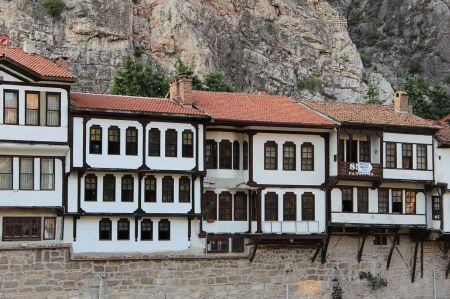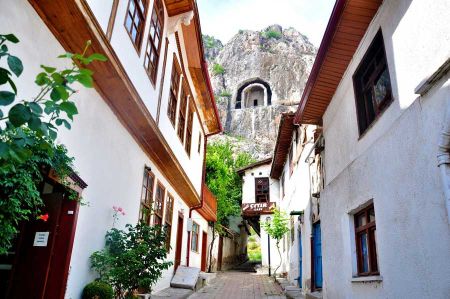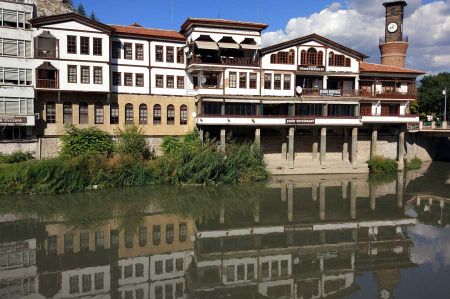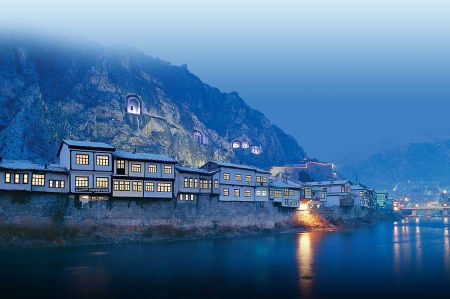Amasya - birthplace of the Historian Strabon
- Written by Portal Editor
The history of the first settlement of the city of Amasya can be traced back to the Hittite peoples because they founded the first settlements here in the Pontic Mountains.
But it was during the settlement by Greek ethnic groups at the time of Hellenism (around 400 BC) that the ancient city of Amaseia was founded, which was the capital of the Kingdom of Pontos for a period of 120 years to around 183 BC.
With the conquest by the Romans in 70 BC (3rd Mithridatic War) Amaseia was assigned to the Roman province of Bithynia et Pontus. A little later, in 25 BC, Amaseia belonged to the province of Galatia.
 With the fall of the Roman Empire, Amasya was passed to the Seljuk King Kiliç Arslan II after an eventful history until it was incorporated into the Ottoman Empire in 1386. Under the Ottomans, Amasya was developed to an important city, since it was the seat of the princes and was often mentioned in one breath with cities such as Oxford or Baghdad as the seat of important training locations with high culture. With the fall of the Ottoman Empire, Amasya became increasingly less important.
With the fall of the Roman Empire, Amasya was passed to the Seljuk King Kiliç Arslan II after an eventful history until it was incorporated into the Ottoman Empire in 1386. Under the Ottomans, Amasya was developed to an important city, since it was the seat of the princes and was often mentioned in one breath with cities such as Oxford or Baghdad as the seat of important training locations with high culture. With the fall of the Ottoman Empire, Amasya became increasingly less important.
The Seljuks and Ottomans followed Greeks and Romans
 From the glorious Ottoman period, the castle, which is still well preserved today, is worth mentioning. It lies on a hill about 250 meters high above the city. In the rocks of the castle hill are some rock tombs that go back to the kings of the Pontos dynasty. Worth mentioning too is the worth visiting Sultan Bayezit Mosque from 1486 and the octagonal Kapı-Ağası Medrese from 1488, which refer to the importance of the city at that time.
From the glorious Ottoman period, the castle, which is still well preserved today, is worth mentioning. It lies on a hill about 250 meters high above the city. In the rocks of the castle hill are some rock tombs that go back to the kings of the Pontos dynasty. Worth mentioning too is the worth visiting Sultan Bayezit Mosque from 1486 and the octagonal Kapı-Ağası Medrese from 1488, which refer to the importance of the city at that time.
It was not until Mustafa Kemal called for the Turkish Wars of Liberation that the city of Amasya regained its popularity on June 22, 1919, because thousands followed the call for national resistance: “The people's independence is regained by the people's determination and decision!"
Provincial capital Amasya on Yeşilırmak
 Today the city has around 80,000 inhabitants, stretches along the Yeşilırmak river on both banks, which are connected by five bridges, and is the provincial capital of the province of the same name, Amasya. Strong earthquakes caused extensive destruction, particularly in 1734, 1825 and 1936.
Today the city has around 80,000 inhabitants, stretches along the Yeşilırmak river on both banks, which are connected by five bridges, and is the provincial capital of the province of the same name, Amasya. Strong earthquakes caused extensive destruction, particularly in 1734, 1825 and 1936.
The most famous "son" of the city of Amasya is probably the Greek historian and geographer Strabon (born 58 BC), who described his hometown in detail in his work Geographika.
Today Amasya is also a meeting point for paragliders, because the thermal conditions ensure good flight conditions and excellent starting options from the surrounding mountains. Some pilots on site ensure annual flight days in this wonderful region on the Black Sea.
Please read as well:
Giresun - small beaches between Pontus and the Black Sea
Bolu at Yedi Göller National Park
